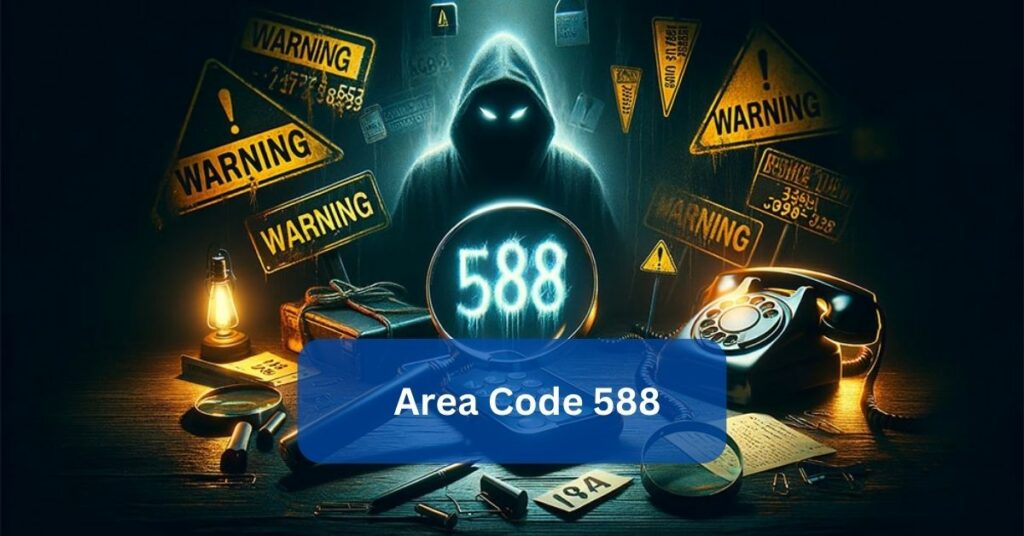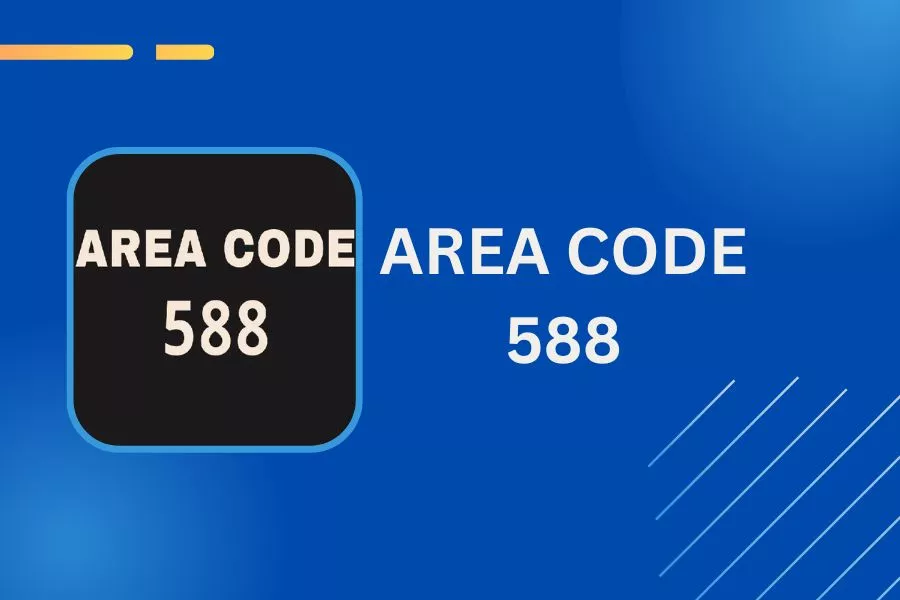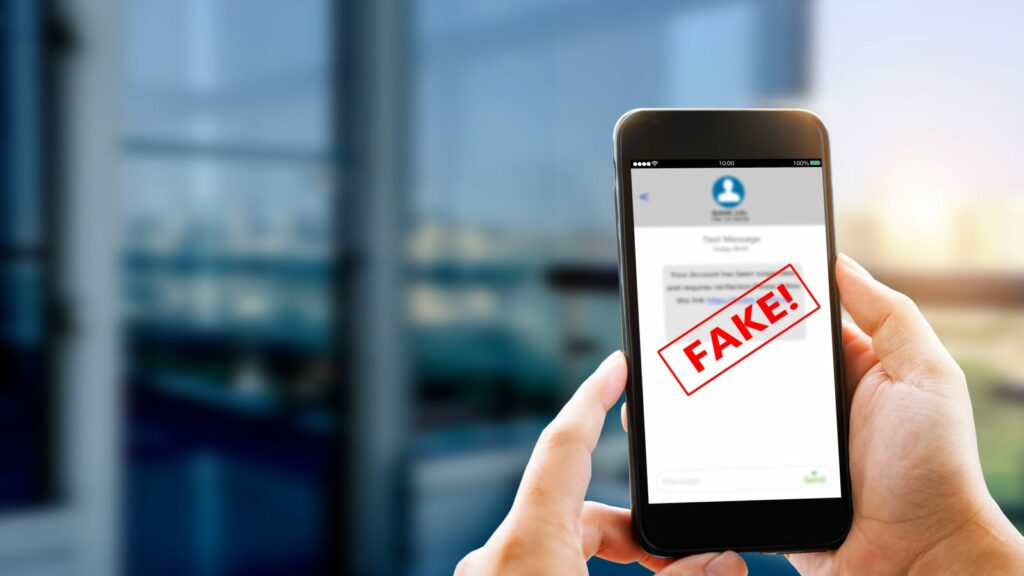Area Code 588 – Cracking the Code And Unraveling the Mystery Behind It

Have you ever received a message or call from the mysterious area code 588 and found yourself puzzled about its origin and significance?
588 area code is indeed used for personal communications, and some companies and services utilizing this code are reportedly located in Kansas City and nearby areas.
Fear not as we embark on a journey to demystify this enigmatic code and equip you with the knowledge to navigate the nuances it presents.
Understanding Area Code 588: A Closer Look
1. What is Area Code 588?
Area code 588 may have caught your attention due to its mysterious presence in your phone’s messages or calls. In this section, we will delve deeper into this unique area code’s origins, characteristics, and implications, aiming to provide you with a comprehensive understanding.
2. The Origin Story:
Area code 588 officially became a part of the North American Numbering Plan (NANP) in 2015. Unlike traditional area codes tied to specific regions, 588 doesn’t conform to geographical constraints. This lack of a specific location association has made it a distinctive player in the telecommunication landscape.
3. The 5XX Format:
One of the defining features of area code 588 is its adherence to the 5XX format. This format is typically designated for specific purposes, and in the case of 588, it is primarily employed for personal communications services (PCS). This format provides flexibility and adaptability, allowing for diverse applications beyond traditional geographic designations.
4. Geographical Independence:
Unlike many other area codes in the United States that are tied to specific regions or states, area code 588 lacks a geographical link. This means that the code isn’t bound by borders, making it a non-traditional player in the realm of telecommunication. The absence of a specific geographic association allows for broader applications and uses.
5. Verizon’s Connection to 588:
Verizon, a major telecommunications service provider, is intricately linked to the narrative of area code 588. This code is often assigned to users who choose not to use Verizon’s Message+ app. In group chats, participants who opt for alternative messaging platforms may find themselves labeled with the 588 area code. While this might initially seem perplexing, it’s an indication that these users need to utilize Verizon’s specific messaging application.
6. Personal Communications Services (PCS):
The 588 area code is dedicated to Personal Communications Services, emphasizing its role in facilitating individual interactions. This designation underscores its application in personal communication scenarios rather than being associated with business or geographic entities. The PCS framework allows for tailored and user-centric communication experiences.
7. Beyond Personal Communications:
While initially intended for personal communications, the use of the 588 area code has evolved over time. Verizon, in particular, utilizes this code not only for personal messaging but also for official communications. This includes sending links, updates, and other personalized messages to its users. The multifaceted nature of 588 highlights its adaptability in serving diverse communication needs.
8. The Kansas City Connection:
While area code 588 doesn’t have a direct geographical link, reports suggest that businesses and services using this code are often situated in Kansas City and nearby areas. This regional association may add a layer of context for users encountering the 588 area code, but it’s crucial to recognize that its application extends beyond a specific location.
The Evolution of Area Code 588 – A Brief History!

The introduction of area code 588 into the telecommunications landscape marked a significant shift in the traditional approach to geographic-based numbering plans. Unlike its predecessors that tied phone numbers to specific regions, area code 588 was introduced with a distinct focus on accommodating the evolving nature of personal communications in the digital age.
1. Early Days– Authorization and Inclusion (2015):
The journey of area code 588 began with its official authorization and subsequent inclusion in the official numbering plan in 2015. This move reflected the recognition of the changing dynamics in communication, with an increasing emphasis on personal interactions that extended beyond geographical boundaries.
2. Personal Communications Services (PCS)– A Paradigm Shift:
Area code 588 was strategically designed to cater to the growing demand for Personal Communications Services (PCS). PCS, in this context, refers to a set of wireless communication capabilities that enable individuals to have personal communication anytime, anywhere.
The introduction of the 5XX format, unique to this area code, signaled a departure from the conventional regional-based approach, emphasizing the personal nature of the connections facilitated by these numbers.
3. Expansion Beyond Geographic Constraints:
Unlike traditional area codes that tied phone numbers to specific geographic locations, the 588 area code broke free from such constraints. This lack of a strict geographical link allowed users to establish connections without being bound by the limitations of traditional area-based assignments. Therefore, the evolution of area code 588 mirrored the broader societal shift towards a more interconnected and globally oriented world.
4. Verizon’s Role– Integration into the Digital Landscape:
Verizon, a key player in the telecommunications industry, played a pivotal role in integrating area code 588 into the digital landscape. As a forward-thinking move, the code was often assigned to users who chose not to adopt Verizon’s Message+ app. This strategic allocation showcased the adaptability of the area code to cater to different communication preferences, further solidifying its position in personal communications services.
5. Applications in the Digital Era–- Beyond Traditional Boundaries:
The incorporation of area code 588 into the official numbering plan aligned with the broader trend of embracing digital communication tools. Its applications extended beyond traditional boundaries, enabling users to engage in personal communications services that were not confined by the limitations of physical locations. This evolution reflected a paradigm shift in how individuals approached and experienced personal connections in an increasingly interconnected world.
6. Challenges and Opportunities– Misuse and Legitimate Use:
While area code 588 brought about a revolution in personal communications, it also faced challenges. Reports of misuse by spammers and telemarketers underscored the need for users to exercise caution.
However, the opportunities presented by this area code for legitimate personal communications and official communications from entities like Verizon showcased its potential to foster meaningful connections in the digital era.
Navigating the 588 Conundrum– What You Need to Know!
1. Messages and Calls from 588– Friend or Foe?
When a message or call from area code 588 pops up, uncertainty might cloud your mind. Is it a friend reaching out or a potential security threat?
Here’s the scoop: while the US Federal Communications Commission officially sanctions the 588 area code, it’s not bound to a specific geographic location. This lack of association can lead to legitimate personal communications and, unfortunately, misuse by spammers and telemarketers.
2. Verizon’s Connection to 588– Decoding the Link:
Verizon, a prominent player in the telecommunications arena, plays a role in the 588 saga. The code is often assigned to users who opt not to use Verizon’s Message+ app.
If you’re part of group chats and encounter a participant with the 588 code, it’s likely because they still need to embrace the Message+ app.
But fear not, for not all messages from 588 are ominous. Verizon utilizes this code for official communications, including links and personalized messages.
Cracking the Code – Your Guide to Dealing with 588!

1. Receiving Messages from Non-Message+ Users– A Common Scenario:
If you find yourself receiving messages from phone numbers starting with area code 588, it’s a telltale sign that the sender isn’t using Verizon’s Message+ app. This typically occurs in group chats where participants opt for different messaging platforms. The fix? Understand the dynamics, and if need be, explore alternatives or encourage others to join the Message+ bandwagon.
2. Restoring Messages– Overcoming the Hurdle:
Encountering issues with accessing group messages due to the 588 area code? Fear not, as restoring messages is a straightforward solution. Open the Message+ app, tap on the stacked lines, select “Restore Messages” from the menu, and voilà—you’re back in the groove of seamless group communication.
Text Messages from Mexico and Other Unusual Scenarios
1. Receiving a Text Message from Mexico– Sorting Facts from Fiction
International texts typically come with a country code at the beginning of the sender’s number. If it’s Mexico, the country code should start with +52, not area code 588. However, the 588 area code may create confusion, especially when utilized by Verizon’s PCS (Personal Communications Service).
This step-by-step guide will walk you through the process of reporting spam messages to Verizon, ensuring a secure and spam-free digital environment.
Step 1: Identify the Suspicious Message:
Before taking any action, identify the message that you suspect to be spam. Ensure that you do not reply to the message or click on any links within it, as doing so could potentially compromise your security.
Step 2: Forward the Message to Shortcode 7726
Verizon has set up a dedicated shortcode, 7726, to report spam messages. Follow these simple steps:
- Open the messaging app on your device.
- Locate the suspicious message you want to report.
- Instead of responding to the message, forward it to the shortcode 7726.
Step 3: Provide “From” Address Details
Upon forwarding the suspicious message to shortcode 7726, Verizon will respond and request information about the “From” address. The “From” address is the phone number or contact from which you received the spam message.
Reply to the message from Verizon, providing the necessary details about the “From” address.
Step 4: Verify Receipt with “Thank You” Notification
Once you’ve provided the required information, Verizon will acknowledge your report. You will receive a “Thank You” notification confirming that your report has been received and is under review.
Step 5: Verizon Initiates an Investigation
With the information provided, Verizon’s security team will initiate an investigation into the reported spam message. This process helps identify potential patterns, protect other users, and enhance overall security.
Alternative Reporting Method for Message+ App Users
If you are using Verizon’s Message+ app, the reporting process is slightly different:
- Touch and hold the suspicious message within the app.
- A new menu will appear; select “Report Spam.”
- This action will not only delete the message from your device but also prompt Verizon to initiate an investigation.
Blocking the Sender Through Your Online Verizon Account
As an account owner or manager, you have the option to block the sender directly through your online Verizon account:
- Log in to your Verizon account online.
- Navigate to the section related to message settings or spam controls.
- Locate the option to block numbers and input the suspicious number starting with area code 588.
Suspicious Phone Calls and Text Messages – A Cautionary Tale:

Area code 588 isn’t immune to misuse, and you might find yourself receiving suspicious calls or texts. If uncertainty clouds the caller’s identity, declining the call or blocking the number are sensible measures. Vigilance is key in thwarting potential scams.
1. Taking Control– Dealing with Suspicious Texts and Calls
Encountered a suspicious text from area code 588? Don’t fret; take action. Forward the message to shortcode 7726, providing the “From” address details. Verizon initiates an investigation to ensure your peace of mind. Alternatively, use the message + app to report spam, keeping your digital space secure.
2. Blocking the Sender– A Powerful Shield Against Spam
Preventive measures are your best bet against spam texts. Verizon’s support team is your ally in this battle. Touch and hold the message, select “Report Spam,” and witness the swift removal of the message along with a notification of its spam status. iPhone users can also block senders easily through their device settings.
Final Thoughts:
As we wrap up our journey through the intricate web of area code 588, remember that knowledge is your greatest ally. With its roots in personal communications services, this non-geographic code can be both a friend and a potential foe.
Should you still grapple with text messages from area code 588, don’t hesitate to contact Verizon’s support team. Their expertise and guidance can unravel any remaining mysteries and ensure a seamless digital experience.
Frequently Asked Questions:
1. Can someone steal my information through a text with area code 588?
While not common, the risk exists. To protect your information, avoid clicking on links or installing unauthorized apps accompanying such texts.
2. How can I identify a scammer texting me from area code 588?
Scammers often use unusually long mobile numbers. Be wary of fake job offers or refund scams.
3. What’s the difference between Messages and Messages+?
Messages+ offers additional features like archiving messages and international texting.
5. Is Message+ free?
The app is free, but sending and receiving messages may incur charges based on your data plan.
Read more:






